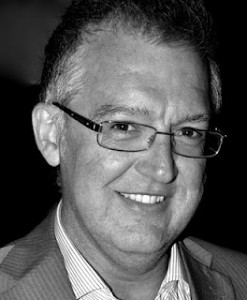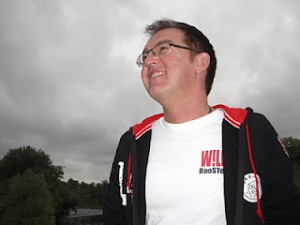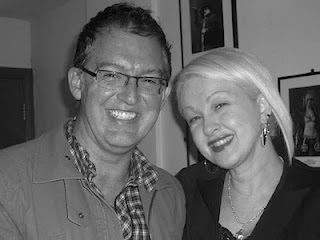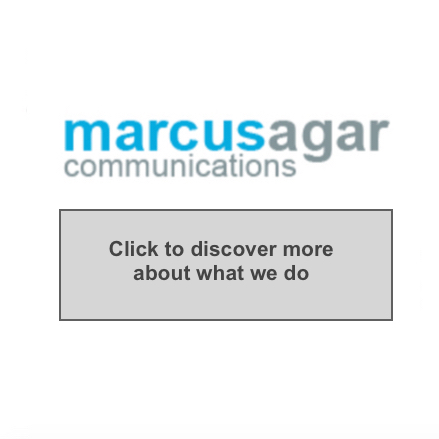Interview: Branding Magazine
For many months, I have been a regular contributor to Serbia’s Branding Magazine. This online magazine has grown into a popular resource for the latest marketing and branding news, presented with a characteristic slant .
![]() During a recent visit to Belgrade, I met with Branding Magazine’s Chief Communications Officer Aleksandar Đuric to share insight on my career and discuss the state of the branding and marketing industry today.
During a recent visit to Belgrade, I met with Branding Magazine’s Chief Communications Officer Aleksandar Đuric to share insight on my career and discuss the state of the branding and marketing industry today.
Marcus Agar is an international communications consultant and journalist with twenty years experiences of delivering integrated campaigns and high profile projects for well-known brands, personalities and businesses. By delivering results that hit their target, Marcus has established a strong reputation and is regularly called upon to counsel senior management and advise teams on how to put in place plans for dynamic external and internal communications programmes that deliver benefits for business, events and campaigns.
So far, we know Marcus as an expert on Branding Magazine and through his columns. He is also a popular blogger knows as Wild Rooster, writing about culture and current affairs in Serbia and the Western Balkans. Branding Magazine sat down with Marcus to explore how he started in journalism, discuss some of his experiences in PR, and hear what motivates him still about branding and communications.
BRANDING INTERVIEW:
Tell us Marcus, what attracted you to journalism and how did you start?
I wrote my first piece aged 15, when the editor of my local newspaper enticed me into writing a weekly music column. I was hooked straight away and I secured a place on a journalism training course in Wales. Throughout my career I have been fortunate to have support from some influential people in our industry. That editor was the first.
 The skills I learned working for newspapers and magazines, especially of how to translate complicated materials and craft a message in a voice relevant to an audience, have served me well to this day. They are the cornerstones of being a good communicator and I call on my journalism training daily. I have always had a passion for writing and I still write for a number of publications. Writing will continue to play an important role in my career.
The skills I learned working for newspapers and magazines, especially of how to translate complicated materials and craft a message in a voice relevant to an audience, have served me well to this day. They are the cornerstones of being a good communicator and I call on my journalism training daily. I have always had a passion for writing and I still write for a number of publications. Writing will continue to play an important role in my career.
I am a strong believer in learning the basics. Often I see people writing without balance or integrity and do not consider the consequence of their words. They clearly cannot write and do not have an appealing style or any sense of responsibility for what they write. Less reputable bloggers are especially prone to this. But these same people then croak about being journalists. Well, they cannot have it both ways.
If you want to be considered a journalist, if you want to speak with any authority on a subject, you should do your research and then write with certain standards. That is valid no matter what it is you write about or where it will be published. I would say that, rather than being outmoded, these guiding principles are even more important with the development of social media. The core values should remain the same.
Was it difficult to bridge from journalism to the communications business?
There are so many former journalists working in communications, it is clearly a transition that works. Many of the skills you learn as a trained journalist are transferrable to other communications industries. Indeed, they can give you a significant boost over those who have worked their way up the marketing tree. That is my own experience anyway. My experience of working in a busy newsroom, understanding what the media want and need, and knowing how to craft a message, have served me well when putting together campaigns that deliver tangible results. As a writer and blogger, my training in journalism law has proved to be invaluable and helps me write with greater confidence and security. I check my facts.
My first job in PR was working for George Michael, as a personal publicist. After a few years promoting events and releases for various music artists and working on fashion shows forGianni Versace, I joined Freud Communications. Brand marketing was taking off in a big way and Freuds was shaping many of PR templates and practices we take for granted today. I had the opportunity to work closely with Matthew Freud and his senior executive which was invaluable experience for me. It was an exciting time to be working with one of pioneers of modern brand communications. In my five years at Freuds, I fronted campaigns for BT, Volkswagen, Pizza Hut, Comic Relief, Sega and Planet Hollywood, worked on brand re-engineering projects for Tango, Vladivar, Holsten Pils and Pepsi, and drove publicity campaigns for chart-topping artists and major Hollywood names. The experience gained during those five years has been invaluable to my career.
You have more than 20 years of experience in the branding industry. How has the industry changed through that period?
The scope of our role has developed and the tools available to us have increased dramatically, although the basics remain the same. The pace of change has been quite incredible, too, with technology being a driver of many of those advances. We have many more tools and channels now, providing far greater means to project an image or amplify a message. When I started, we didn’t even have internet or email and computers were essentially just word processors. It is quite astonishing when I look back to the start of my career: the things we did because the tools we take for granted today were not available back then. And I’m really not that old!
 One big change we have seen is the active role that consumers take in their communication with brands. Barriers have been broken down and consumers expect a greater dialogue with their preferred brands. They feel they have a right to voice their opinion on anything a brand does, whether good or bad. Some brands are still not totally relaxed in this new space. We need to listen more and, if comment is relevant and fits within the framework of a brand’s personality and values, there is scope to make changes to reflect that feedback.
One big change we have seen is the active role that consumers take in their communication with brands. Barriers have been broken down and consumers expect a greater dialogue with their preferred brands. They feel they have a right to voice their opinion on anything a brand does, whether good or bad. Some brands are still not totally relaxed in this new space. We need to listen more and, if comment is relevant and fits within the framework of a brand’s personality and values, there is scope to make changes to reflect that feedback.
Consumers expect much more. They are harder to please and it takes a lot to awaken the wow factor. They have seen it all before. But that is what makes it so exciting, that constant challenge to push further. This is definitely not an industry where we can rest back on our laurels. We have to be on the ball more than ever before.
I often work on internal communications campaigns, and this is an area where we have seen significant improvements in the appreciation for the job there. Indeed, it is good to note that we have become far more recognised for the work we do as communicators to develop, establish and maintain a brand. That is a positive development. It was not always that way, I can tell you.
What kind of impact has been provided by your PR campaigns for successful brands such as Pepsi, Volkswagen and Pizza Hut?
When you work with major brands on international product launches, a strong PR campaign should tie in with the other marketing disciplines. The best way to deliver results on that scale is to integrate your ideas with the campaign theme. If your ideas hit the right spot, PR can even be the driver of a campaign, with advertising, DM, POS etc all following your lead. That is when you really feel the buzz. I have had that a few times.
Evaluating the impact PR is always a disputed science, but there are ways to establish the success of a campaign right from the start. The key is to fully understand a client’s business objectives, maybe even beyond the limited remit of the campaign you are working on. Once you know that, you have the goalposts to aim for. It is not all about media coverage.
For Pepsi, we were working on the major Pepsi Blue re-engineering project as well as various music projects and on-can promotions. All of these received extensive media support and awareness levels were seen to rise significantly. For Pizza Hut we worked alongside the advertising company to drive celebrity ambassador campaigns associated with new products or promotions and helped to launch new restaurants in the UK and Europe. Our communications, both in media and in store, made a significant impact on the take up of the new product range and increased footfall. Volkswagen was a very interesting client for me, bringing together much of my experience to date. They chose to sponsor tours by the Rolling Stones and Eric Clapton to borrow their rock credentials to push the VW Golf range and launch the new Beetle. The Rolling Stones campaign was especially strong across Europe – and it meant that I saw the band playing live quite a few times that year!
Can you describe for us the re-launch of Walkman brand and your work on interesting projects at Sony?
It was an interesting time to be working with the audio division of Sony, as the brand’s key business areas were experiencing great change. Sony has always been an innovator in bringing consumer technology to market, with the Sony Walkman brand being a perfect case in point. But the goalposts had moved. Not only were there more players on the field, the whole game was changing. People were accessing music and TV in quite different ways and Apple was running away with the portable music market. To maintain its position as a major player in that market, Sony recognised that it needed to adapt itself to the new conditions. With the heritage of the Walkman brand, it had a head start. So we worked with Sony to develop and roll out an international campaign that built on the history, reputation and recognisability of the Walkman brand and Sony’s association with music artists to position a new range of music players and software.
 At the same time, we were launching Sony’s high-end range of Wega TVs across multiple European territories. Obviously this is a crowded marketplace and consumer choice can be burdened by jargon and tech-speak. Our approach was to create cut-through and relevance for consumers by commissioning a director to make a fascinating documentary about the life of a supermodel. This was screened to media and made available online for consumers, to breath life in to the key attributes of the product range: clarity, reality and colour.
At the same time, we were launching Sony’s high-end range of Wega TVs across multiple European territories. Obviously this is a crowded marketplace and consumer choice can be burdened by jargon and tech-speak. Our approach was to create cut-through and relevance for consumers by commissioning a director to make a fascinating documentary about the life of a supermodel. This was screened to media and made available online for consumers, to breath life in to the key attributes of the product range: clarity, reality and colour.
You have worked with the biggest names in entertainment, including George Michael, Puff Daddy, Madonna and Rolling Stones, as well as movie names such as Tim Burton, Stephen Dorff and Sylvester Stallone. How has that shaped your view of personal branding and what changes have you seen for publicists?
Some of my greatest career moments have been while working in entertainment publicity. I have toured with bands I love, been a celebrity publicist at pivotal times in their career, and I have promoted major properties like the Harry Potter and Matrix movies and hit TV shows The Sopranos, Friends and The West Wing.
It is not all about private jets and parties in Cannes though. It is hard work and you are kept on your toes. The challenges are great and the hours are long. But, yes, the rewards make it worthwhile. Most of the time, at least. I toured the religious sites of Israel and Palestine withJean Claude van Damme, which was a memorable experience.
Personal branding has become even more important with the advent of social media, when celebrities have their own social presence and some of them quite like the sound of their own voice. Followers expect to have a dialogue with a celebrity directly. They do not want a gatekeeper issuing statements or controlling the messaging, although often they are still pulling the strings the emerald curtain.
Musicians are even more dependent on protecting their image now that record sales have plummeted and the need to explore more financially beneficial routes such as live shows and merchandising have created a greater importance for a strong, recognisable brand that attracts fans who will spend their hard earned cash. There is still a whole industry managing their image.
So yes, the role of a publicist has changed in some ways. But the job is still to amplify and protect an image, just as with any other property. We all know that a brand is a celebrity and a celebrity is a brand, and both need people to keep the show on the road.
 One of the most interesting developments is in personal branding, where everyone now has their own brand to consider and protect. Every comment, status update and photo we place on social media sites reflects on our own image and can be accessed by everyone from friends and family to employers and even government agencies. With great freedom comes greater responsibility, which can be a hard lesson to learn. The consequences if we get it wrong can be quite extreme, as some people have seen with high profile results, such as media exposure or losing their jobs.
One of the most interesting developments is in personal branding, where everyone now has their own brand to consider and protect. Every comment, status update and photo we place on social media sites reflects on our own image and can be accessed by everyone from friends and family to employers and even government agencies. With great freedom comes greater responsibility, which can be a hard lesson to learn. The consequences if we get it wrong can be quite extreme, as some people have seen with high profile results, such as media exposure or losing their jobs.
Having worked for many international broadcasters, what do you think about the state of TV branding?
Working with any TV channel can be interesting and challenging. Content is king, as the phrase says, and a channel is only as good as its current programming. You need to enhance the personality of the core channel brand by championing its crown jewels programming. That is how viewers experience the brand.
In terms of branding, there is a bond of trust with any chosen media, be it press, broadcast or online. You invite these brands into your home and allow them to deliver content direct to your family. You expect certain qualities and standards, whether that might be for the most balanced news coverage, the latest films or the funniest cutting-edge comedy shows. That is what you are dealing with when you are representing a channel rather than a programme.
Traditionally, viewers had very strong relationships with TV channels. They had their favourites and they stuck with them. That has changed in recent years. Brand loyalty is not as strong as it was and that is a challenge facing TV networks. New channels crop up almost overnight, while others rebrand with snappy new names as they try to claw their way back into our viewing habits, and all at a time when old viewing models are being thrown out the window. TV scheduling is almost a thing of the past, with time-shifting and online channels allowing us to pick and mix what and when we want to watch. For many people, YouTube has become an essential channel.
Traditional channels have to extend their presence via branded online and mobile routes or even go niche to have a chance of survival. At the moment, we are seeing a lot of local channels cropping up, and it will be interesting to see how that develops in coming years. A lot of channels will not survive, but that is not necessarily a bad thing, in my opinion.
When I started working the HBO account, our brief was to prepare the ground for a greater presence in the UK by building on the reputation and credentials of programming like The Sopranos, Six Feet Under and Sex and the City, which we were already promoting. For the Mouse House, content was definitely king. The family of channels under the Disney Branded Television banner have a strong reputation with their core audiences. They are trusted to provide safe quality viewing for children and parents feel comfortable with the Disney brand. Our role was to raise the profile of Disney’s cornerstone programming to promote and reinforce that trust and expand the base. But we had to protect that brand at all costs.
You have also worked for other familiar international brands, we believe?
I have worked extensively on FMCGs and consumer technology brands, that is true. I have been very fortunate to work on international product launches and campaigns for many high street brands, such as Pizza Hut, Kodak, Pepsi, Warner Bros, Sega, Sony, Cadbury, Tangoand BT. I have also represented such diverse global properties such as Miss World and a winner of the Nobel Peace Prize. As different as those sound, you might be surprised how similar the work can be. For Miss World, there is a lot of strategic engagement with senior international stakeholders, which is often where I can add most value.
A key reason for my continued success is that I add value at a senior level. Yes, I can deliver strong campaigns that attract media coverage but, more importantly in some ways, I also listen, guide and coach a client in how best to achieve what matters most to them. The first job of anyone in communications should be to listen. Only by listening can we appreciate the real issues and then start to identify the best possible solutions. That is what I have always tried to do, anyway.
Is it possible for an old marketer to survive in the upcoming digital years?
I definitely hope it is: I’m banking on it! Seriously, though, it is perfectly possible. Indeed, it can be the better option in some cases. Obviously some people will fall by the roadside but those who grasp the new challenges and are excited by the opportunities they present will still thrive. Past experience can be an significant asset to how we perform in the new space. What is important is for people to be willing to adapt their approach to suit the new channels and techniques, while bringing into play the high value of their experience. If you stop doing that, you will be left behind, that is true. Business benefits from experience as well as creativity.
 Increasingly, brands and businesses call on my experience to advise teams on putting together an effectual campaign. They value the perspective that comes with experience. I coach a lot of business leaders and work closely with SMEs to advise on their communications and social media activity. One product I am rolling out in Serbia and Bosnia is a communications health check for businesses and NGOs to evaluate and calibrate their efforts. In the current climate, and with the opportunities that a new relationship with the EU will present, there is an appetite for this service and I am well positioned to share the benefits of my experience.
Increasingly, brands and businesses call on my experience to advise teams on putting together an effectual campaign. They value the perspective that comes with experience. I coach a lot of business leaders and work closely with SMEs to advise on their communications and social media activity. One product I am rolling out in Serbia and Bosnia is a communications health check for businesses and NGOs to evaluate and calibrate their efforts. In the current climate, and with the opportunities that a new relationship with the EU will present, there is an appetite for this service and I am well positioned to share the benefits of my experience.
One of the great things about marketing and communications is how it is an ever-changing world. There is always more to learn. The possibilities are getting greater and the job is becoming even more exciting. I am pleased to be in an industry where I can take advantage of the technological advances to spark a conversation between brands and stakeholders. It is a very stimulating time to be working in any form of communications or marketing.
Thank you Marcus for your time, it has been a real pleasure to interview you.
Thanks for your interest. I have been quite brief on some answers that really deserved more space but I hope that your readers will found it interesting. I am a great supporter of Branding Magazine and the work that you are doing to spotlight the best branding stories, always adding your own voice to the mix. Too many publications rely on press release cut-and-paste jobs, which is not what I expect from my media. The skill lies in knowing what is of interest to your reader and providing a context or even an opinion on the relevant facts.
![]() Click here to see the version of this interview published on Branding Magazine. With thanks for Aleksandar Đurić for showing interest and conducting this interview.
Click here to see the version of this interview published on Branding Magazine. With thanks for Aleksandar Đurić for showing interest and conducting this interview.


No comments yet.
Be first to leave your comment!